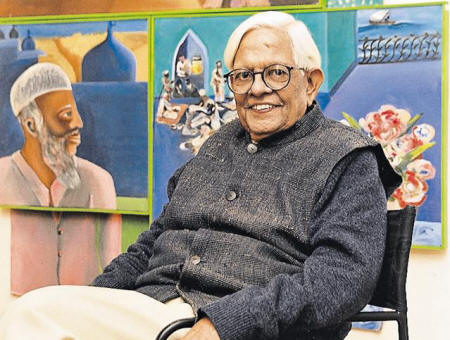

 Bhupen Khakhar (March 10, 1934 - August 8, 2003) was a contemporary Indian artist.
He earned an international reputation for paintings that are
explicitly homosexual in theme, but that also address universal human needs. They are rooted in traditional
Indian art, but are startlingly original.
Bhupen Khakhar (March 10, 1934 - August 8, 2003) was a contemporary Indian artist.
He earned an international reputation for paintings that are
explicitly homosexual in theme, but that also address universal human needs. They are rooted in traditional
Indian art, but are startlingly original.
Born in 1934 in Bombay, the self-trained painter lived and worked in Baroda, India. To satisfy the expectations of his family and other members of the middle class, Khakhar initially trained as an accountant. But he had always wanted to become a painter, so he decided to pursue his love for art when he was in his late twenties. As a consequence, he moved to the university town of Baroda in 1962 and completed a degree in art criticism. Although inspired by traditional Indian painting styles, Khakhar's visual language is completely original. Initially a painter of complex, finely detailed, brightly colored scenes of everyday life, he began painting works with blatant homosexual themes during the 1980s. This type of "coming out" was unprecedented in Indian culture; although many Indians are homosexuals, same-sex themes are exceedingly rare in modern Indian art. Khakhar frequently painted men nude with erect penises. They touch one another and gaze lovingly into each other's eyes. In the work entitled Two Men in Benares (1985), for example, two standing, life-size, nude men hug one another in the left third of the composition. Vignettes of everyday life fill the remaining two-thirds of the canvas. While a wall separates the upper half of the two men from these scenes, the area that surrounds them from the waist down bleeds into the vignettes. Although partially separated from the scenes, then, the two men are also integrated into them. Khakhar frequently created secondary spaces in his paintings that are filled with scenes of daily life. This compositional strategy broadens the interpretation of his works. For example, the vignettes in Two Men in Benares encourage the viewer to interpret the work as a visual statement about the life experiences of homosexuals in India. Khakhar used a narrow band of everyday scenes, this time at the top of the canvas, to make the fantastic primary theme of his painting Yayati (1987) seem more realistic. According to a myth taken from The Mahabharata, the king Yayati, through a curse, began to age prematurely before he had satisfied his sexual appetite. Puru, his youngest son, agreed to exchange his youth for his father's age. In Khakhar's painted interpretation, this exchange occurs through penis-to-penis contact. Yayati, with white wings, an erect penis, and jewel-toned purple and green skin, hovers prone over Puru, who holds his penis in his right hand. The background, a radiant, seemingly undulating pink, serves to create a plausible alternate reality. The everyday scenes at the top of the canvas heighten this impression as trees grow from, and people walk around in, the pink area. Although Khakhar experienced prejudice and violence as a result of his sexual preferences, his paintings do not function as protests. Saturated with jewel-toned colors, decorated with gorgeous landscapes, and peopled with a variety of human figures co-existing in harmony, they are celebrations of love and contentment. Many of the figures in his works gaze into each other's eyes with mutual love, understanding, and desire. Although homosexual in theme, Khakhar's works address universal human needs such as physical closeness, interaction, and pleasure.
Khakhar died on August 8, 2003 in Baroda, India, aged 69.
My published books: